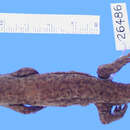Description
provided by AmphibiaWeb articles
Batrachuperus yenyuanensis total length ranges from 163-211 mm in males, 135-175 mm in females. Head is flat, longer than wide. Snout rounded and covered with thick labial folds. Vomerine teeth short, with 3-6 on each side, large gap in between the two rows of teeth. There is a groove running from the eye to the noticeable jugular fold. Adult has no or trace remnant of gills. Body is slender, dorsum and venter are relatively flat, and the skin is smooth. 11-12 costal grooves are present. Tips of forelimb and hindlimb toes overlap at the tip or are separated by 1 costal groove length when limbs are adpressed to the flank. There are four unwebbed toes on each forelimb and four unwebbed toes on each hindlimb. The tail is longer than SVL, with a thin, tall fold.Batrachuperus yenyuanensis has either a dark brown, dirty yellow, or bluish-gray colored dorsum, overlaid with irregular, dark cloud-like patterns. The pattern fades going from the flanks towards the venter. The venter is grayish yellow.
Distribution and Habitat
provided by AmphibiaWeb articles
This species is endemic to China, in the province of Sichuan. It is found in montane rivers and creeks at elevations from 2900 - 4400 m above sea level. Most Batrachuperus yenyuanensis spend their time near water and hiding under cover of river rocks, with a few choosing to shelter in dirt tunnels on the bank.
Life History, Abundance, Activity, and Special Behaviors
provided by AmphibiaWeb articles
During the cold weather of October to February, adult salamanders sometimes hibernate under the same rock. Oviposition begins at the end of March. The female lays a pair of egg sacs, one end attached onto the underside of river rocks, with 6-13 eggs in each egg sac, 12-25 eggs in total. Egg sacs are slightly curled and range from 70-125 mm in length and 8-15 mm in diameter. Eggs are white in coloration.
Life History, Abundance, Activity, and Special Behaviors
provided by AmphibiaWeb articles
A major threat is the local collection for food and medicine. This species has a low reproductive rate and needs to be better protected.
Yenyuan stream salamander: Brief Summary
provided by wikipedia EN
The Yenyuan stream salamander (Batrachuperus yenyuanensis) is a species of salamander in the family Hynobiidae endemic to Sichuan, China, where it occurs in Yanyuan, Xichang, Mianning, and Puxiong counties. Its natural habitats are rivers, freshwater lakes, and freshwater marshes. It is a high-altitude salamander, typically inhabiting the waterways along the eastern edge of the Qinghai-Tibetan Plateau at altitudes 2440 to 4025 meters above sea level. Adults eat a diet consisting mainly of insects and shrimp, and to a lesser degree, algae and seeds. It is threatened by habitat loss.
- license
- cc-by-sa-3.0
- copyright
- Wikipedia authors and editors

